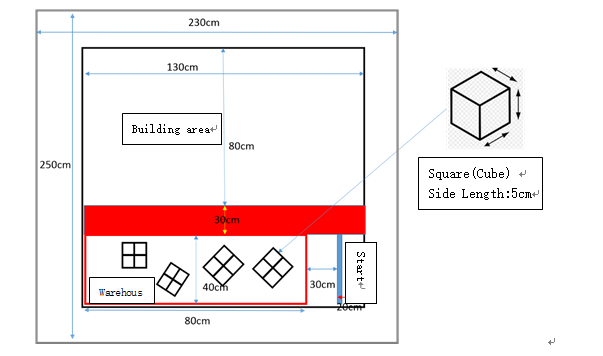2020 International autonomous intelligent robot competition
Running-Robot 2020

“Block Tower” Challenge Round Rules and Arrangements V3.2
Contents
Chapter 1 Competition Rules 3
1. Teams and robots 3
2. Challenge scenarios and tasks 3
3. Number of rounds of challenge and calculation of achievements 4
4. The ending conditions of each round of challenge and the judgment of the success of the challenge 4
Chapter 2 Competition arrangement 6
1. Team order 6
2. Pre match preparation 6
3. Enter the competition 6
4. The competition is going on 7
5. The end of the game 7
6. Other instructions 7
Appendix - 2020 "Block tower" challenge scene 9
1. Venue 9
2. Tasks 11
3. Robot requirements
Chapter 1 Competition Rules
1. Teams and robots
Those who are willing to participate in the challenge will organize their own teams to apply to the Organizing Committee of the competition.
The number of participants in each team shall not exceed 5.
The robot participating in the challenge must be able to complete upright walking and other action tasks independently and intelligently (i.e. taking action without human intervention) in complex environment and according to specific environment conditions. "Robot walking upright" refers to the robot simulating human to move on the track in a way that only the sole of the foot (without other parts) contacts the ground and supports the whole body.
The participating robots must be the robot hardware (and development board) designated by the competition organizing committee or submitted to the Competition Organizing Committee for approval. See the attachment for a description of the reference dimensions.
2. Challenge scenarios and tasks
The challenge arena is divided into warehouse area and construction area. At the beginning, the blocks are stored in the warehouse area. The task of the robot is to move the blocks from the warehouse area to the building area by the way of two hands holding or two arms holding, and build the block tower in the building area, so that the tower body is stable and the height meets the specified requirements under the condition that the robot does not touch the tower body. Blocks falling between the two zones shall not be picked up again. Each side of the square is red, white, blue, orange, yellow, green and other monochromatic colors, or a mixture of several monochromatic colors.
See the attachment for specific parameters of scenario and challenge task requirements.
3. Number of rounds of challenge and calculation of achievements
Each team can participate in 2 rounds of challenges at most. If the first round is successful, they will not participate in the second round.
The "maximum time" for each round of challenge is 8 minutes.
All teams complete the first round of challenge. After that, all the teams that failed in the challenge tried the second round of challenge.
4. The ending conditions of each round of challenge and the judgment of the success of the challenge
In each round of challenge, when one of the following conditions is met, the round of challenge ends:
(1) When the robot completes the challenge task;
(2) When the team touches the robot;
(3) When the robot leaves the field;
(4) When the robot moves the block from the warehouse area to the building area, it does not pass through the area between the two areas by holding the block with both hands or holding the block with both arms and walking upright, or picking up the block falling between the two areas;
(5) When the challenge reaches the maximum time。
When the robot finishes building the tower, and the tower height reaches the specified height without touching the tower body, then "challenge succeeded"; otherwise, "challenge failed". The challenge results are not ranked, and all the successful teams will share the rewards.
For specific height parameters, see the attachment.
Chapter 2 Competition arrangement
1. Team order
The teams will draw lots before entering the competition.
2. Pre match preparation
(1) Each team, according to their own schedule, will enter the preparation area in advance before the start of the challenge, complete the robot debugging, confirm the only (robot) "operator" and other preparations, and report "ready" to the referee;
(2) After receiving the "ready" report, the referee and staff will check the team and robots to see if they meet the challenge requirements and confirm that the team is "ready". If the requirements are not met, the referee has the right to require the team to prepare again;
(3) 10 minutes before the start of the competition, if the referee cannot confirm "ready", the challenge will be withdrawn.
3. Enter the competition
(1) "Ready" teams bring robots into the competition area. The operator places the robot at the starting point and signals that the referee is ready;
(2) The referee randomly stacked the blocks in the warehouse area;
(3) The referee declared "the challenge begins" and started the timing device at the same time. After the challenge is announced, the operator can start the robot. If the operator starts the robot first, he will be warned by the referee; if he starts again, he will be disqualified.
4. The competition is going on
(1) From the beginning to the end of the challenge, only the operator can enter the site and operate the robot as required. In the challenge, no one else can operate the robot in any way. In case of violation, you will be disqualified;
(2) It is the operator's responsibility to ensure that all of his operations comply with the rules of the game. If any operation does not meet the competition rules, it will be disqualified.
5. The end of the game
(1) The referee declared "the end of the challenge" according to the rules;
(2) After the challenge, the referee is responsible for calculating the score and filling in the report card according to the rules. The team confirms the report card of the team and leaves with its own robot.
(1) If there are any changes to the rules of the competition, the organizing committee will inform all teams in the first time;
(2) In the competition, the referee has the power to decide. If you have any objection, please submit it to the referee after the match;
(3) The organizing committee is responsible for the final determination of all objections and the resolution of all disputes.
Appendix - 2020 "Block tower" challenge scene
1. Venue
The site area is 2.3m x 2.5m.
The field area is 1.3m x 1.5m, and the main body is the melamine board with pitted surface, and the surface color is gray. The static friction coefficient between the track road surface and the robot foot is about 0.1 (each team can stick anti-skid materials on the robot foot as required). There is a ring of fence advertising around the site, the fence is about 50 cm away from the track boundary, with LOGO on it; there is ground advertising on the ground in the spare area. The specific distribution is shown in the figure below:

The venue is located in the center of the venue - corresponding to the black border area in the figure, which is at least 15 cm higher than the surrounding ground. In the figure, the peripheral gray sideline is the enclosure position. "Robot leaving the field" means that the robot falls to the ground outside the field.
There are warehouse area and construction area in the stadium. The area of the warehouse area is about 80cm x 40cm, the boundary is marked with red tape, and the width of the boundary line is 5 cm. The building area is about 80cm x 130cm.
There is a 30 cm wide separation zone between the warehouse area and the building area. The surface of the strip is red and is a separate and removable floor. "Block towers built in the construction area" refers to those block towers that still stand in the construction area after the isolation belt is removed. "Block falling between two zones" refers to all the blocks entering the separation zone.
The starting line of the robot is 30 cm away from the warehouse area. "Put the robot at the starting point" means that the foot of the robot is close to but does not touch, not to exceed the starting line.
At the beginning of the challenge, 20 blocks were randomly stacked in the warehouse area. The square is a conventional engineering plastic cube with a size of 5 x 5 x 5 cm, hard and frosted surface, with a weight of about 60 g, and each color is set at will. In order to ensure the random stacking of boxes, the referee can use a square box of about 60cm x 30cm, first collect the boxes and stack them randomly in the box, then place the boxes in the warehouse area.
2. Tasks
The standard of success of the challenge is to build a square tower with a height of 5 cm higher than the shoulder of the robot in the building area. "Tower height" refers to the vertical distance between the highest point on the tower and the ground of the arena when the square tower is stable; the measurement accuracy is 1 cm, rounded down. "Robot shoulder height" refers to the vertical distance from the finger to the highest point within the range of elbow joint to the ground when the robot is in an upright state and the arm is extended horizontally and perpendicular to the trunk.
3. Robot requirements
The robot can be the designated robot of the competition, or the robot designed and manufactured by the team or modified by itself, but it cannot be the robot other than the designated robot and not modified by itself. Robots designed and manufactured by ourselves or modified by ourselves must meet the following requirements and be reviewed and approved by the Organizing Committee of the competition:
(1) Foot humanoid robot, two upper limbs;
(2) Robot size: shoulder height > 25 cm, height < 50 cm, width and thickness under natural standing state < 30 cm, (highest point height shoulder height when upper limb is lifted) < 15 cm, and (shoulder height lowest point height when upper limb is dropped) < 15 cm.

